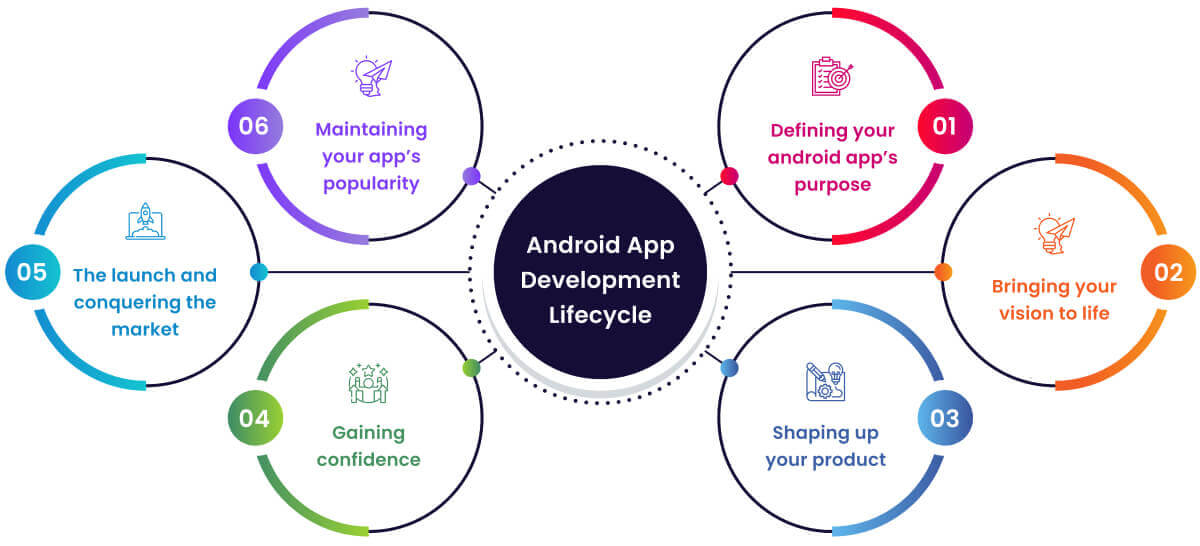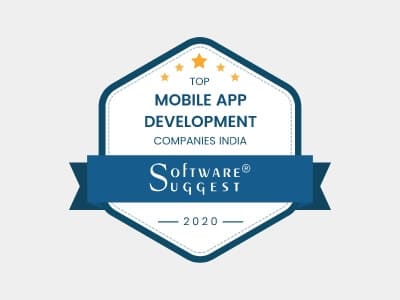Listen to the podcast :
Mastering the Android app development lifecycle is key to creating a successful app. This involves planning, designing, developing, testing, deploying, and maintaining your app. By understanding each stage, you can turn your idea into a reality and make a lasting impact on the Play Store.
According to the research giant Statista, in February 2024, around 52 thousand mobile apps were released through the Google Play Store. The total number of Android applications in the store is 2.43 million and the figure changes every hour, every minute.
All businesses are now making Android applications for their businesses to reach every user because every user is a potential customer.
No matter whether you are a startup, SME, or an established company, without a mobile app, your business visibility is tremendously affected, and you are at a great loss. So, hurry, outsource the Android app development project to an offshore software development company to get in the league of the competitive market, and stay ahead.
Is your business ready to turn ideas into impactful Android apps?
But wait! Do you have any idea about how Android application development happens at a renowned mobile app development company? Since you are outsourcing your project, it is essential for you to understand the lifecycle of Android app development and customization. If you know this process, you are in a better position to discuss and take cognizance of your app project. This short guide on the lifecycle of Android app development just helps you understand the required steps.
A Guide to Android App Development Lifecycle
It all starts with having a small idea about your business. The purpose is to automatize internal and external processes of your enterprise and reach potential customers or end users with software solutions so that they can easily navigate your products and services and can avail them from their handheld devices.

The entire Android app development lifecycle can be divided into phases.
- Defining your Android app’s purpose
- Bringing your vision to life
- Shaping up your product
- Gaining confidence
- The launch and conquering the market
- Maintaining your app’s popularity
1. Ideation and Planning: Define your app
Before a single code is written, you need to take quality time to study your target market and its requirements. Brainstorming and prioritizing features can resonate with your users and build a unique value proposition for your app, making it an essential strategy for any business investing in Android applications.
- Market research: Conducting thorough research to learn existing applications of competitors will help you understand the potential ap your app can fill.
- Feature prioritization and UX design: Once you identify the target end users, call all think tanks and stakeholders to ponder over the app’s features. Which features are needed primarily and what all intuitive UI can be designed for the best user experience is planned out.
2. Bring your Vision to Life: Design and Prototyping
In this Android app development lifecycle, it’s essential to begin by translating your product’s functionalities and user flow into precise, low-fidelity mockups. These mockups serve as the blueprint for crafting an intuitive and engaging UI. Once you have a solid foundation, it’s time to hire Android developers who can bring your vision to life, building the basics before tackling more complex features.
- Wireframing and UI design: Go for low-fidelity mockups to map out the app’s functionalities and user flow. You may need to follow wireframes to create a visually appealing and engaging UI design aligning with Android’s Material Design guidelines.
- Prototyping: You can create a basic and interactive prototype that enables users to use the app’s core functionalities. With this, they will provide valuable inputs and feedback before the full-fledged and complete version of the Android app begins.
3. Development – Shaping up the Product
In this stage of the Android app development lifecycle, your product gets the body and soul. Hire Android app developers offshore to save bucks though you don’t compromise on quality at all. WeblineIndia comes as your best tech companion here.
- Choosing the right development approach: Depending on the Android app development requirements, as a tech partner, we may adopt one or a combination of more than one software development methodology such as agile, waterfall, and the like.
- Coding and development tools: The right Android app development tech stack is extremely essential to select for your project. You may take an expert’s help in choosing the best coding and development tools for the Android platform that are both economical and authentic.
4. Testing and QA – Gain Confidence
Before you release your product, this phase of the Android app development lifecycle undergoes vigorous tests to check whether the product is ready to face users with its features and functionalities. Quality Assurance is the backbone of any product.
- Rigorous testing: Testing the product is one of the most essential steps in the Android app development lifecycle. Rigorous testing is performed to assure quality, functionality, compatibility, and performance. Tests are performed for the latest Android versions and different hardware options.
- Beta testing: In this Android app development lifecycle phase, a selected group of beta testers are invited to use the application and provide their feedback on usability issues, bugs, and overall UX.
5. Deployment and Launch – Conquer the Market
Your product is ready for the battle in the market. In this stage of the Android app development lifecycle, the product is launched on the selected network or platform. It is now ready to showcase your company’s strength and capability.
- App Store Optimization: Known as ASO, it is essential to optimize your app’s listing on Android i.e. Google Play with relevant keywords, descriptions, and high-quality screenshots. It helps in the discoverability of your Android app.
- Launch strategy: Launching is important in spreading good words about your Android app across the Play Store. It must generate excitement and involve social media campaigns, influencer marketing, and PRs.
6. Maintenance and Updates – Keep the App alive and kicking
Your Android app development lifecycle doesn’t end—it continues with mobile app maintenance and updates, during which the app’s health is regularly checked. Any bug fixes, feature updates, or changes in functionality are carried out at regular intervals.
- Performance improvement: Bug fixing and optimization are performed regularly to ensure that your Android app is up and running all well. Bug fixing is also performed depending on the feedback of users which showcases your promptness in solving their issues.
- New features/updates: Maintenance of Android app development is not all about bug fixing. It also includes new features or updates regularly. With changing market and consumer demands, regular updates to include newer functionalities are covered in maintenance.
Want to build a custom Android app that stands out on the Play Store?
Enhancing the Android App Development Lifecycle with Tools and Techniques
1. Planning and Ideation
- Wireframes: Tools like Figma or Adobe XD map out the app’s structure.
- Technical Feasibility: Assess challenges early with feasibility analysis tools.
2. Design and Prototyping
- Documentation Tools: Confluence or Google Workspace streamline collaboration.
- KPIs: Set performance metrics to measure design efficiency.
3. Development
- APIs & Integration: Use Postman for seamless third-party integration.
- Resource Management: Jira or Asana for effective planning.
- Back-End Assessment: Platforms like Firebase ensure reliable infrastructure.
4. Testing and QA
- Automation: Selenium or Appium accelerate testing.
- Feedback Tools: UsabilityHub gathers insights through beta testing.
5. Deployment and Launch
- ASO: Optimize listings with AppTweak or Sensor Tower.
- Performance Metrics: Google Analytics tracks app performance.
6. Maintenance and Updates
- Monitoring: New Relic ensures stability post-launch.
- Bug Fixing: GitHub streamlines updates based on user feedback.
Customizing the Android App Development Lifecycle
1. Tailored Planning for Cost and Risk Reduction
- Requirement Analysis: Customize the planning phase to focus on identifying and mitigating project-specific risks.
- Timeline Development: Create bespoke timelines that align with your business goals and app priorities.
2. Enhanced Prototyping and User Research
- Prototyping: Develop prototypes that address unique app needs and facilitate early feedback.
- User Research: Conduct custom user research to align app features with target audience preferences.
3. Streamlined Resource Management
- Resource Allocation: Tailor resource planning using tools like Jira or Asana to ensure optimal utilization.
- Increased Visibility: Implement tracking mechanisms to monitor project progress in real-time.
4. Usability Testing for Market Readiness
- Usability Testing: Adapt testing phases to reflect specific user flows and use cases.
- Marketing Strategy Integration: Sync lifecycle stages with promotional strategies for a cohesive launch.
5. Customizing Maintenance and Updates
- Streamlined Tracking: Monitor app performance and implement updates that respond to user feedback.
- Tailoring Lifecycle Stages: Continuously evolve the development process to meet changing business needs.
Ready to build a customized Android app?
Now that you are acquainted with the entire Android app development lifecycle, WeblineIndia is all set to help you with the best product. Simply fill out the form and we shall contact you to discuss your business idea. At WeblineIndia, Android application development kick-starts as early as three business working days. So, don’t wait, just drop us a line and we will be on the smooth journey of Android app development for your enterprise.
Social Hashtags
#AndroidAppDevelopment #AppDevelopmentLifecycle #AndroidLifecycle #AppDevelopment #PlayStore #AppPlanning #AndroidDevelopers #Androidapp #AndroidDevelopment #OffshoreDevelopment
Looking for an offshore team to build scalable Android apps for your business?
Testimonials: Hear It Straight From Our Global Clients
Our development processes delivers dynamic solutions to tackle business challenges, optimize costs, and drive digital transformation. Expert-backed solutions enhance client retention and online presence, with proven success stories highlighting real-world problem-solving through innovative applications. Our esteemed Worldwide clients just experienced it.
Awards and Recognitions
While delighted clients are our greatest motivation, industry recognition holds significant value. WeblineIndia has consistently led in technology, with awards and accolades reaffirming our excellence.

OA500 Global Outsourcing Firms 2025, by Outsource Accelerator

Top Software Development Company, by GoodFirms

BEST FINTECH PRODUCT SOLUTION COMPANY - 2022, by GESIA

Awarded as - TOP APP DEVELOPMENT COMPANY IN INDIA of the YEAR 2020, by SoftwareSuggest